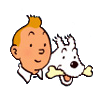No edit summary |
|||
| Line 3: | Line 3: | ||
==History== |
==History== |
||
| − | In [[1935]], six years after ''[[Tintin]]'' had first appeared in ''[[Le Petit Vingtième]]'', Hergé was approached by Father Courtois, director of the weekly French newspaper ''Coeurs Vaillants'' (''Valiant Hearts''). ''Coeurs Vaillants'' also published Tintin's adventures, but while Father Courtois enjoyed ''Tintin'', he wanted a set of characters that would embody classical family values, by way of a young boy, with a father who works, a homemaker mother, a sister and a pet — in contrast to the more independent Tintin who, the whole of his career, had no mention of relatives whatsoever. Inspired by a toy monkey called Jocko, Hergé created Jo Legrand, his sister Zette and their pet monkey Jocko as well as their engineer father, Jacques, and housewife mother. |
+ | In [[1935]], six years after ''[[Tintin]]'' had first appeared in ''[[Le Petit Vingtième]]'', Hergé was approached by Father Courtois, director of the weekly French newspaper ''Coeurs Vaillants'' (''Valiant Hearts''). ''Coeurs Vaillants'' also published Tintin's adventures, but while Father Courtois enjoyed ''Tintin'', he wanted a set of characters that would embody classical family values, by way of a young boy, with a father who works, a homemaker mother, a sister and a pet — in contrast to the more independent Tintin who, the whole of his career, had no mention of relatives whatsoever. Inspired by a toy monkey called Jocko, Hergé created Jo Legrand, his sister Zette and their pet monkey Jocko as well as their engineer father, Jacques, and housewife mother.Their first adventure, ''The Secret Ray'' appeared in the pages of ''Coeurs Vaillants'' on January 19, [[1936]] and ran until June [[1937]]. It was also published in ''Le Petit Vingtième'' as well. Between 1936 and 1957, three complete ''Jo, Zette and Jocko'' adventures were published across five separate albums. Hergé however often felt restricted by the family set-up: whereas the older, more independent Tintin could just head off on any adventure, either alone or with friends like [[Captain Haddock]] and/or [[Professor Calculus]], this was not possible for Jo, Zette and Jocko whose parents had to feature in any adventure — usually to act as their rescuers. The stories also lacked the subliminal social and political messages of the Tintin stories. In the end, these constraints would eventually lead him to abandon ''Jo, Zette and Jocko'' in [[1958]] |
| − | |||
| − | Their first adventure, ''The Secret Ray'' appeared in the pages of ''Coeurs Vaillants'' on January 19, [[1936]] and ran until June [[1937]]. It was also published in ''Le Petit Vingtième'' as well. Between 1936 and 1957, three complete ''Jo, Zette and Jocko'' adventures were published across five separate albums. Hergé however often felt restricted by the family set-up: whereas the older, more independent Tintin could just head off on any adventure, either alone or with friends like [[Captain Haddock]] and/or [[Professor Calculus]], this was not possible for Jo, Zette and Jocko whose parents had to feature in any adventure — usually to act as their rescuers. The stories also lacked the subliminal social and political messages of the Tintin stories. In the end, these constraints would eventually lead him to abandon ''Jo, Zette and Jocko'' in [[1958]] |
||
[[Category:Publications]] |
[[Category:Publications]] |
||
[[Category:Alternate Hergé Works]] |
[[Category:Alternate Hergé Works]] |
||
Revision as of 23:33, 30 March 2014

From left to right: Jo, Jocko and Zette.
The Adventures of Jo, Zette and Jocko is a comic book (or bande dessinée) series created by Belgian artist/writer Hergé. The protagonists of the series are two young children, brother and sister Jo and Zette Legrand and their pet monkey Jocko. Jo, Zette and Jocko have appeared on the rear covers of some The Adventures of Tintin editions, but never appear in the stories.
History
In 1935, six years after Tintin had first appeared in Le Petit Vingtième, Hergé was approached by Father Courtois, director of the weekly French newspaper Coeurs Vaillants (Valiant Hearts). Coeurs Vaillants also published Tintin's adventures, but while Father Courtois enjoyed Tintin, he wanted a set of characters that would embody classical family values, by way of a young boy, with a father who works, a homemaker mother, a sister and a pet — in contrast to the more independent Tintin who, the whole of his career, had no mention of relatives whatsoever. Inspired by a toy monkey called Jocko, Hergé created Jo Legrand, his sister Zette and their pet monkey Jocko as well as their engineer father, Jacques, and housewife mother.Their first adventure, The Secret Ray appeared in the pages of Coeurs Vaillants on January 19, 1936 and ran until June 1937. It was also published in Le Petit Vingtième as well. Between 1936 and 1957, three complete Jo, Zette and Jocko adventures were published across five separate albums. Hergé however often felt restricted by the family set-up: whereas the older, more independent Tintin could just head off on any adventure, either alone or with friends like Captain Haddock and/or Professor Calculus, this was not possible for Jo, Zette and Jocko whose parents had to feature in any adventure — usually to act as their rescuers. The stories also lacked the subliminal social and political messages of the Tintin stories. In the end, these constraints would eventually lead him to abandon Jo, Zette and Jocko in 1958
